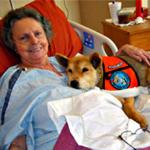12 January 2010
Until his recent death at the age of 19, Baxter was America's oldest working therapy dog, visiting patients in hospitals and hospices. In a new memoir, Moments with Baxter, Melissa Joseph shares stories about her trained assistance dog.

www.momentswithbaxter.com
For more than 17 years, Baxter was Melissa Joseph's companion and best friendBaxter was about two years old when Melissa Joseph adopted him, and she and the golden retriever-chow mix spent the next 17 years together.
Finding a friend and an opportunity
"He and I were inseparable. We ate together. He was always in the car with me. He was never left at home alone. He went to work with me. He went everywhere with me," Joseph says.
At the time, Joseph didn't realize she was grooming and training Baxter to become a therapy dog. That happened eight years later.
"One day, my husband came home after having met a couple who volunteered at San Diego Hospice and said, 'I really think we should do something like that as a team, as a couple, so that it could help our relationship,'" she recalls. "So we went to the orientation program and Baxter was with us. At the end of that 35 hour orientation – it lasted several Saturdays – the orientation staff came to me and said, 'Your dog is remarkable. We think he would be an addition to our team. You must get him certified,'" Joseph recalls.
Baxter becomes a certified therapy dog

www.momentswithbaxter.com
In her book, "Moments with Baxter", Joseph shares true stories about the connection Baxter made with terminally ill peopleTo get Baxter certified as a therapy dog, Joseph had to make sure he was comfortable in all sorts of situations, and with all sorts of people. Then, he started a mission that lasted more than eight years at San Diego Hospice, which cared for people with terminal illnesses.
"You would think at the end of someone's life that they would not want to meet a new person and bring new people into their sphere," she says. "But the moment people would see Baxter's face – he looked like a little Teddy bear – they wanted to touch him. There were people who didn't even like dogs and all of a sudden, they would have Baxter in their arms and have his eyes looking at them. He would completely change the dynamics in the room. Oftentimes, he would be [able to calm] any kind of anxiety that they couldn't mitigate with medication. And I would chronicle that day after day, week after week, year after year and finally I said, 'Oh my God, I've got a book about this magical hero,'" she says.
Baxter gave dying patients unconditional love
"Moments with Baxter" is a collection of 36 true stories.
"One of the more remarkable stories for me was when he was ahead of me walking into this room that we were asked to go into and the gentleman had a very rare disease," he says. "He had these huge growths, cysts – cantaloupe-sized – all over his body. I noticed that Baxter immediately walked up to the gentleman who was in the wheelchair and started licking his hand and I wanted to turn and walk out because I couldn't seem to get around the way he looked. Then I said, 'You know, if Baxter can do this, I can do this.' Two-and-a-half hours later, the three of us were on the sofa and Baxter had half of his body on this gentleman's lap and I was next to the gentleman rubbing shoulders with him," Joseph says.
Connecting with young and old

www.momentswithbaxter.com
Children loved BaxterBaxter also connected with children, including one six-year-old boy, Joseph recalls. "He was in such agony in such physical pain and the doctor said to me, 'We're at this point where we've done everything we could and maybe Baxter can help.' So we put Baxter in bed with this guy. This little boy didn't speak with anybody but all of the sudden, he started talking to Baxter. I think it's just the magical power of that love that's for free."

www.momentswithbaxter.com
Baxter's unconditional love gave him the ability to connect with people regardless of their ageSuch unconditional love and comfort, Joseph explains, is what makes therapy dogs able to connect with people regardless of how young or how old they are.
"There was a woman whose last dying wish was to go see the latest Harry Potter film that came out a couple of years ago," she says. "We made some arrangement with the hospice and the movie theatre for Baxter to accompany her to watch the Harry Potter film. All her friends, she had 28 friends who came, and there was Baxter, side by side [with her] in the movie theater, eating popcorn. She said that it was the happiest day of her life. Several weeks later, when she returned to the inpatient care center to die at San Diego Hospice, Baxter was the last person that she touched before the end of her life."
As service animals dogs offer versatile skills
While dogs are not the only therapy animals, they are the most common. Laurie Hardman, director of Project Canine, a therapy provider in Seattle, Washington, says dogs can provide more than just affection.

www.momentswithbaxter.com
Joseph plans to train another therapy dog to continue the mission she started with Baxter"There are so many animals that can offer some sort of interaction with people," she says. "I evaluated all sorts of animals from cats, to rabbits to birds to rats, miniature horse, pot belly pigs – [even] llamas can make visits. Dogs tend to be the best because we can direct them more easily. We can teach them more specific skills. We can work them for people that need physical therapy. Say somebody, they've had a stroke and they may need to try to strengthen an arm that has been affected. They can throw a ball for a dog to retrieve. That makes their therapy much more interesting and pretty much you're not going to get a cat to do that," Hardman says.
Joseph says working with her therapy dog was such a rewarding experience that she plans to continue. She is looking for another dog she can train to become her next healing hero.